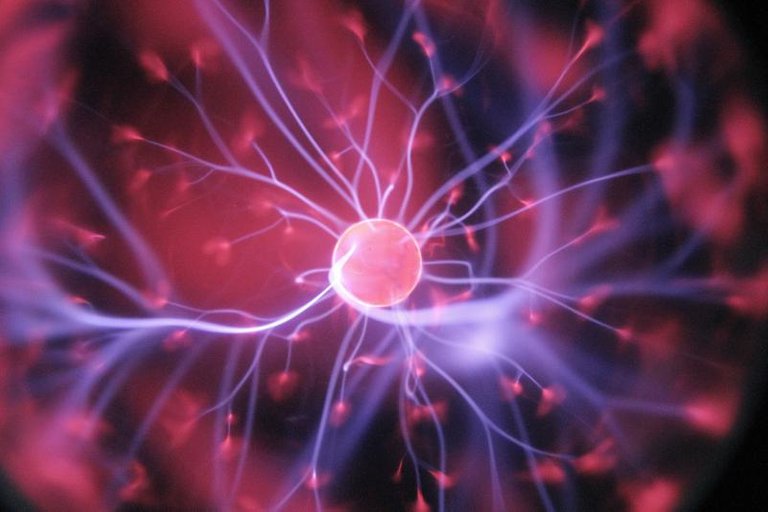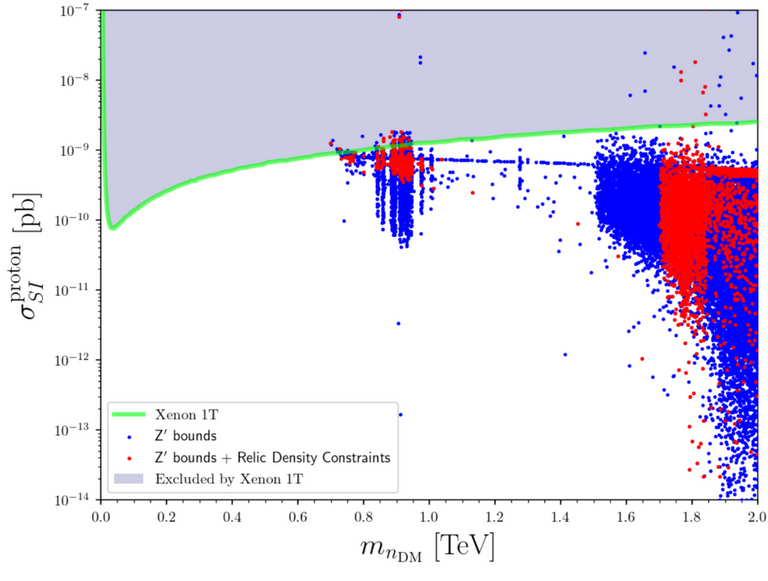In our world, we have many classes of forces that can act on the objects surrounding us. All those forces however result from only four fundamental interactions: gravity, electromagnetism, the strong force and the weak force.
The Standard Model of particle physics focuses on the last three of these forces, gravity being negligible for an elementary particle. While this allows for a successful description of nature, physicists have nevertheless been trying to unify these forces into a single one for a long time.
In such a Grand Unified Theory, all known interactions can be seen as different facets of a single force.

[Credits: Hal Gatewood]
In this blog, I discuss one of my recent research articles, in which we studied a particle physics model emerging from a Grand Unified Theory. Our motivation followed from the dark side of that model: It not only features a way to unify all known interactions, but also offers a solution to the dark matter problematics.
Fundamental interactions in a nutshell
In particle physics, everything can be related to symmetries.
This is in particular true for the fundamental interactions: they are related to the so-called gauge symmetries. Without digging too much into details, one imposes a theory without interaction to be invariant under some transformations, and the fundamental interactions come for free as a result.
The strength in this approach is that it explains most particle physics data available today.

In practice, an interaction between two elementary particles is seen as an exchange of a gauge boson (or a force carrier), a particle that mediates one of the fundamental interactions.
For instance, an electromagnetic interaction will be seen as the exchange of a photon between two other particles.
There hence are three sets of gauge bosons in the Standard Model. Photons mediate the electromagnetic force, the W and Z-bosons mediate the weak force and the gluons mediate the strong force.
Unification and its dark matter consequences
With grand unification, all fundamental interactions are combined into a single force. Similarly, the photon, the gluons, the W and the Z bosons are merged and seen as the different facets of the mediator of the unified force. The pattern featured by the fundamental interactions is hence greatly simplified.

In addition, Grand Unification also combines the elementary building blocks of matter. Several different known particles (quarks, electrons, neutrinos, etc.) become different excitations of a single species.
However, the grand unified symmetry imposes the way to do so, which automatically leads to the prediction of new particles.
In the model investigated in my article, many new particles are around. This includes new force carriers, new Higgs bosons and a new partner for the electron and the neutrino: the scotino (this name was introduced 10 years ago).
The scotino is a new weakly-interacting neutral particle. In other words, it possesses the properties necessary for being a dark matter candidate. However, is scotino dark matter a viable option for dark matter?
Scotino dark matter
In our article, we have verified under which conditions the scotino could viably be dark matter and have properties not violating any observation. The results can be shown (for instance) in the figure below in which we have scanned over the numerous model parameters.

[Credits: arxiv]
The x-axis represents the mass of the scotino, and each (blue or red) point on the figure consists in one scenario not excluded by searches for a sign of a new interaction at the Large Hadron Collider at CERN, those searches being relevant for any grand unified framework. The red points are the interesting ones: the amount of dark matter is exactly what is needed by cosmology.
In addition, there are various experiments on Earth aiming at directly detecting dark matter. They have not observed anything so far. This leads to the excluded grey region. The y-axis of the figure is relevant for those experiments, as it represents the interaction rate of a scotino with normal matter.
We are left with two clusters of red points. In other words, the scotino mass is not free anymore. Moreover, for all those red points, it turned out that the mass of many other new particles was fixed too. The model has thus become very predictive.
In our work, we further investigated to which extent those particles could be observed during the future LHC runs. The results were quite amazing: the model should either be discovered at the LHC, or mostly excluded!
Summary - scotino dark matter may be behind the door
In one of my latest research articles, I studied a framework featuring the unification of the fundamental interactions. This model predicts the existence of many new particles, one of them having the properties required by dark matter.
We have first verified under which conditions those properties were compatible with collider and cosmological data. The findings were very surprising: cosmologically viable scenarios could be realised. All those scenarios predicted that the masses of many new particles were fixed, independently of the scenario, despite of the large amount of freedoms in the model. There is thus not so many fundamentally different setups!
Moreover, we have shown that those scenarios had great chances of being detectable in a close future at the LHC at CERN, so that the model (and scotino dark matter) has great chances of being either discovered or excluded in the next few years.
PS: This article has been formatted for the STEMsocial front-end. Please see here for a better reading.
You know, I like to use visuals...pictures to express concepts and themes. As I was reading this post I had the impression of lightly skipping across rocks in a stream. The concepts you introduce in your blogs build upon each other so that as I read about symmetries, the standard model, and scutinos there's a continuity. There's a sense of progress (in my understanding).Hello @lemouth,
Today my stepping stones, I think, were in this paragraph:
and this sentence:
Of course I don't understand everything here--how could I? But I understand what you're striving for.
I know these posts must be a lot of work, especially because you have to 'translate' for those of us who don't have a technical vocabulary. Thank you for making the effort to share this exciting research, and for educating us, ever so gently, about particle physics. (I didn't even know what that was before I read your blogs.)
Thanks a lot for your nice words, and I am happy to see that you managed to get the concepts. This is by far not easy to make understandable, but I have a lot of fun in doing so.
The two quotes that are mentioned are among the most important concepts shared in this blog. This is at the core of how any fundamental force is modeled in particle physics.
I would be happy to provide more inputs where needed.
Thank you! What I have done is review some of your previous posts (especially the one on "mirrors") so that I can put my new information in context. Slowly I'm developing my own "unified" system of understanding :) If I could think of a specific question, I would ask it. Thank you for the offer.
Ah yeah I remember those. This was some time ago :)
The pleasure is for me. I am here for this ;)
I only have one question, if particle physicists eventually find what they have been looking for in dark matter, what would it mean to the origin of the universe? will it be helpful in elucidating the big bang theory? Where do you think we will go from there if the big bang theory is eventually unraveled?
Thanks for the questions. I will try to answer them but feel free to come back to me if needed. :)
The standard model of cosmology includes dark matter and the big bang. Therefore, finding dark matter will allow us to fill one link that is still missing: what is the exact nature of dark matter. So far, we indeed do not have any elementary particle explaining it.
In fact, things happen in the other way round: we usually construct dark matter models in a way they agree with cosmological data.
Well above my physics background but we'll written and explained. Can you tell me as at why LHC has not detected Scotinos yet? Is it the experimental conditions that need changing (looking from a different angle) or simply a matter (pun intended) of chance?
Thanks for the question.
If you check on the last figure with the cluster of red points, they all lie in a regime where the scotino is quite massive. This means, that if this particle exists, its production rate is quite small (heavier a particle is, harder it is to produce it). As a consequence, we do not have today enough data to have enough scotino (still assuming they exist) to notice something weird with respect to the Standard Model background.
The conditions will change in the future when the LHC will enter its high-luminosity phase (a much larger rate of collisions). At this point, data will be accumulated much faster and we will hopefully have a better grasp on the super rare phenomena.
Ah, I see. Thanks for clarifying that! Exciting times ahead then! Good luck with that!
Thanks! :)
wish you luck with finding empirical evidence to support your model! But it seems to me that we currently live in an age of particles when perhaps it would be very helpful to look at nature in terms of fields as well. Can a field be explained with particles?
Thanks for the comment! There are actually many items to discuss here :)
Technically, I won't do it, as this is not my job. I am a theorist. What I can do is to interpret what experimentalists will (or won't) find, and draw the corresponding conclusions on the model (if they don't do it). Is the model excluded, is it still viable with respect to data, etc. Both excluding a model and discovering something allow us to move forward.
Just to clarify one important point: the model is not mine. It was proposed 10 years ago by other physicists. I only made predictions in this theoretical framework and compared them with data. Very often some physicists propose a model, other works out some specific implications, others work out some other part and so on. We all have different strengths :)
The article I refer to here lies definitely on the phenomenological side: we don't propose any model ourselves but study instead deeply an existing one in the light of recent data.
I introduced the word "particle" here for the sole purpose of the readership (that I expect not to be physicists). The entire theoretical framework is of course defined in terms of fields: the model itself is a quantum field theory, and any given "particle" can thus be seen as an excitation of a field.
Off topic, but I saw an article the other day with a theory that black holes are dark matter stars, and that the event horizon is not a sphere but toriodial, the physicist making the claim asserts this gives a simpler explanation for the particle jets observed; as matter and light falls toward the torus it orbits the event horizon through the doughnut hole and some is ejected perpendicular to the plane of the torus.
There is also a claim that the interior of the event horizon is a different phase of space time, constituted of condensed dark matter, which means that there can be a transition of some matter/light back through the event horizon making the black hole actually a very dark grey doughnut.
Not provable at the moment, and it seems the theory isn't well received, but hopefully some observations can clear it up.
Do you have some references for that article?
In principle, primordial black holes can be dark matter (but not "stars"). I have written a few blog articles on that here and there, that you may find interesting.
I am a bit confused by the rest of your message, which is why I would like to have a look to your references to be able to provide a better answer. Technically, the event horizon can be seen as a sphere from the eyes of the human observer. In contrast, the matter accretion disk is of a torus shape. Maybe the two are mixed in the article?
In addition, we have no access to spacetime located inside the event horizon. Anything falls forever inside (including dark and normal matter, as well as light).
I am again a bit puzzled by the claim. I will thus wait for the sources :)
For sure I will not have grasped the concepts properly.
I managed to find the article https://getpocket.com/explore/item/are-black-holes-actually-dark-energy-stars?utm_source=pocket-newtab-global-en-GB
Ah ok, this makes things clearer :)
I didn't know about this idea (and have not read anything deep on it). However, the article dates from 2018 (this can be guessed from the last paragraph), and Chapline's work is actually a little bit older (2014-2015 I think, after a quick search on the web). In the meantime:
Therefore, I am quite unsure Chapline's theory survives the most recent data (and this is probably why it is not followed by the astrophysics community).
What did you think of the idea of different phases of space-time (not novel AFAIK), for example our current universe being in a phase that condensed out of a higher energy phase, and at some point before heat-death, parts of the universe may condense into a lower energy phase. In terms of defining these "phases", they may have radically different particles, forces and laws.
Pure speculation?
The universe is expected to have gone through different phases, or epochs, during it history. I am not sure this is what you want to talk about.
For instance, we have the so-called electroweak phase transition corresponding to the restoration of the electroweak symmetry (strictly speaking, this is a cross-over in the Standard Model but not necessarily in its extensions). On each side of the transition, the laws of nature are different (here, the particles are massless prior to the transition).
So not, this is not speculation, but expected! :)
Thanks, I dont have a highly defined expectation of what the phases were, but certainly if the laws of nature changed then that is consistent with what I was talking about.
Out of this world theory and practice, truly scientific work and great community around it. Good luck going further with your experiments!
Thanks a lot! For the record, I would like to emphasise that this is by far not my experiment, but the experiment of the entire world (there are tens of thousands of researchers behind the LHC physics programme).
regarding our debate a while back, I stumbled upon this interesting paper and thought it might be of interest to you:
Debated Models for Galactic Rotation Curves: A Review and Mathematical Assessment
https://www.mdpi.com/2075-4434/8/2/47
I unfortunately have no time to read a 35 pages article at the present time (end of the year, university business, etc.).
From my diagonal reading of the article (I won't pretend having done more), they propose to explain the rotation curves by two models. However, I have the impression that those models are only fits. In other words, they are cooked to reproduce data and do not predict anything to be further tested. As a physicist, my interest is therefore quite limited and I find the comparison with particle physics models a bit misleading (this compares apples with pears). Dark matter or MOND models predict many other stuff that can be tested outside the scope of the rotation curves.
Their last paragraph in the conclusion is also quite weird: this is not a matter of two camps (MOND vs dark matter). In addition, they say we should explore new avenues (which I agree with), but what they propose is not such an avenue (it is just the fit of a function).
But maybe I am incorrect (I repeat, I haven't read the paper deeply).
Woah!! Dear particle physicist is back with Scotino Dark Matter!!...and Grand Unification!
Best of Luck!!
I have never left. I was just busy with other matters so that I had no time to write (writing such blogs takes some time, believe me :) ).
Haha! Great!
Thanks for your contribution to the STEMsocial community. Feel free to join us on discord to get to know the rest of us!
Please consider supporting our funding proposal, approving our witness (@stem.witness) or delegating to the @steemstem account (for some ROI).
Thanks for using the STEMsocial app
, which gives you stronger support. Including @stemsocial as a beneficiary could yield even more support next time.
Congratulations @lemouth! You have completed the following achievement on the Hive blockchain and have been rewarded with new badge(s) :
You can view your badges on your board And compare to others on the Ranking
If you no longer want to receive notifications, reply to this comment with the word
STOPDo not miss the last post from @hivebuzz:
Support the HiveBuzz project. Vote for our proposal!